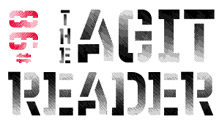
The Spirit of the Radio
by Kevin J. Elliott
Though it’s cliched for a band to cite “everything” under the sun as an influence, it’s fitting when listening to the attentionally deficit, craftily stitched, pseudo-plunderphonics of Tom Van Buskirk and George Langford. As Javelin, the duo inconspicuously released their debut, Jamz and Jemz, housed in repurposed album covers scoured from dollar bins. At first, there was no face to the idiosyncratic nature of their compositions. Jamz and Jemz played like your favorite mixtape culled from deft dubs from pop radio, exotic pirate broadcasts, and bootlegs siphoned from block party DJs. But these weren’t carefully constructed strings of loops and samples. Though one could swear they’ve heard bits and pieces swimming around in the subconscious, nearly every bit of Javelin’s music comes from live playing, manipulations, and stretching the boundaries of formative crate-digging. Think of it as a thrift-store Avalanches or a thinking man’s Girl Talk, but without the legal hassle involved in paying for your fodder.
When it came time to reveal themselves as more than simply button pushers and knob twiddlers, the duo went into their lab convinced they could concoct something that was a cohesive statement without sacrificing their penchant for spanning the radio dial both left and right. No Mas is that record. Scaling back the frenetic edits of Jamz and Jemz to focus on the art of the perfect pop song, Javelin is still never comfortable to fall back on any one particular genre. “Dep” is chilled in twinkling quiet storm thumps. “Moscow 1980” arrives as a disco-inflected autobahn companion, while “Shadow Heart” blooms into a raved-up slice of northern soul. In between the oddball high-pitched electro-funk of the standout “Oh Centra” and the hot-on-the-block breeze of “Vibrationz,” the duo touch down briefly in patches of Afropop, ’60s garage rock, and primitive 808 hip-hop. That sense of never settling has been presented on stage, symbolically and functionally, in a mountain of used and abused boom boxes. This visual trademark is not only a conversation piece in the live setting, but the duo’s own version of a Jamaican soundsystem. Techincal difficulties aside, as an emblem for the future of assembled sonic collages and making pop music from junk scraps, Javelin’s boombox experiment is an intriguing novelty with some stunning results.
I recently spoke with Javelin’s George Langford shortly after the duo’s first cross-country tour. Among other things, we discussed the pros and cons of pigeonholing a group like Javelin and the challenges of performing with a stable of fidgety boomboxes.
I suppose I’m most interested in how you arrived at this sound. Were you and George in more traditional rock bands before Javelin or have you always been tinkering around with electronics and dance music?
George Langford: Tom arrived at this sound through messing around with turntables and samplers. He was on it a little earlier than I was. When we were teenagers, I was playing guitar. I was really into blues and jazz, but we both joined forces when we found we had a mutual love of home recording. I stopped playing with ensembles because I realized that as a multi-instrumentalist I could do it all with a multi-track recorder. Back in the day, it wasn’t dance music per se, but we were into dub reggae—not so much making dub, but the engineering and learning how to twist knobs and faders in order to make new music.
You’re both originally from Providence. As Javelin, were you a part of the noisier scene that percolated with the RISD kids or were you outcasts at all for what you were doing?
GL: When I moved there, I did not fit in at all. I gradually came to realize it was an “anything goes” environment. As long as you were putting yourself out there and taking risks, you could be on a bill at a space or a house with the most hardcore noise deconstructionists then go and play pop R&B and it still goes over great. People are really open-minded there.
Jamz and Jemz sounds much more discombobulated compared to No Mas. How did you approach the recording of this record compared to that first album?
GL: Jamz and Jemz was never meant to be an album. It was more a mixtape sampler of what we were doing. It was constantly evolving. When we did No Mas, working with a real record label, we had to make a record that had some type of unity, even if our songs went all over the place. It’s easy for us to be scattered and quite hard for us to make something that fits together. We never stick with the same thing for more than two songs. Making a cohesive album was a good exercise.
You’re often aligned with cratediggers and DJs who opt to reassemble samples, but your songs are actually composed of all original tracks, correct? Was there a time when you were using samples as a platform?
GL: We are always using samples and records. The thing is we don’t use them the way people want us to use them. It’s hard to describe. If I use a sound from a record, it’s more about texture and sounds than the record. In an extreme sense, it doesn’t matter even what the record is because the sample will be very small, and I’ll manipulate it to sound however I want. We don’t take loops and play over them—it’s more complicated than that. We want to make these sounds into instruments and perform with them like a keyboardist.
I think even amongst those artists like the Avalanches and RJD2, who are concocting this type of kitchen sink dance music, No Mas is quite unique. Can you name some records or artists that inspired what you are doing with Javelin?
GL: The simple answer is all of them. We love all kinds of music. That’s an easy thing to say, but it’s true of us. I can find something to like in everything. On tour, we are content just to listen to the radio. It comes down to loving aspects of all kinds of stuff and having the attention deficit to want to bridge all styles. What I like is that I think we show that impact of everything in our music.
There’s also a tendency for you guys to be described as “novelty” or “comedic” in your execution, and I think that just stems from the variety in your music. Do you have any thought as to why you get those labels?
GL: When people talk about us being “fun” or “goofy,” the thing I’m most afraid of is that they don’t think we’re serious about what we’re doing. But we are incredibly serious about how we make this stuff. The main goal is to breathe life into this prerecorded music. On the other hand, our biggest fear is to be labeled as a serious electronic act. There’s nothing more boring to me than that. We really just want to create a block party vibe where any kind of record can be thrown on at any time.
That might also come from the way you play live, with a stack of boomboxes as opposed to laptops and turntables. How did you come around to that type of set-up and how do you utilize them on stage?
GL: I really like the image of a boombox on the sidewalk in the sun, playing some awesome summertime music. I like the sound of music coming through a boombox. Tom has been collecting vintage boomboxes for some time, and I’ve always had one in the studio and found myself tailoring my music to sound good coming out of the boombox. Our sound is all over the place like a radio dial. Live we use an FM transmitter, to have a mobile soundsystem, like they do in Jamaica. This is our version of that, a crappy junk store soundsystem constructed with boomboxes. We’re still figuring out the best way to do it. In a large venue, people can’t hear the boomboxes, so they think it’s just a visual thing. In a smaller place, they make their presence known. They are pretty unruly actually. They kind of sound awful, so it’s a work in progress.
